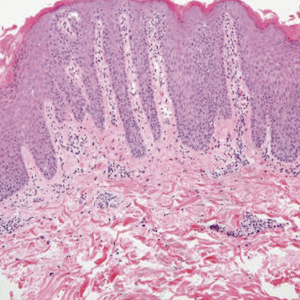Implications of interleukin-17 in psoriatic lesions as Koebner phenomenon caused by recurrent occupational burns

Accepted: 16 September 2022
HTML: 7
All claims expressed in this article are solely those of the authors and do not necessarily represent those of their affiliated organizations, or those of the publisher, the editors and the reviewers. Any product that may be evaluated in this article or claim that may be made by its manufacturer is not guaranteed or endorsed by the publisher.
The Koebner phenomenon (KP) is the emergence of new lesions in an uninvolved skin area caused by different types of stimulations, including mechanical stress, chemical stress, trauma, or injury. KP affects patients with certain skin diseases and is frequently observed in patients with psoriasis. We report the case of a 43-year-old obese male welder who developed psoriatic lesions only in areas of repeated burns due to his occupation. He was repeatedly exposed to mild burns in his anterior neck and the periorbital region as he was welding without shield protection. Subsequently, erythema appeared in the same region. Skin appearance and skin biopsy suggested psoriasis vulgaris (PV), and immunohistochemical analysis of anti-interleukin (IL)-17, a crucial element in the development of PV, showed the positivestained cells. The anti-IL-17 staining was prominent around the thickened epidermis as psoriatic lesions. IL-17 produced by T helper 17 cells stimulates keratinized cells and promotes chemokine secretion involved in neutrophil migration. Our case showed that patients, even without a history of PV, may have a risk of developing KP and PV via the enhanced production of IL- 17 locally in the repeated burn area. No recurrence of skin symptoms was observed when the patient used a fully defensive shield during welding.
Boyd AS, Neldner KH. The isomorphic response of Koebner. Int J Dermatol 1990;29:401-10.
Ji YZ, Liu SR. Koebner phenomenon leading to the formation of new psoriatic lesions: evidences and mechanisms. Biosci Rep 2019;39:BSR20193266.
Arias-Santiago S, Espineira-Carmona MJ, Aneiros-Fernandez J. The Koebner phenomenon: psoriasis in tattoos. CMAJ 2013;185:585.
Picciani BLS, Domingos TA, Teixieira-Souza T, et al. Evaluation of the Th17 pathway in psoriasis and geographic tongue. An Bras Dermatol 2019;94:677-83.
Sun L, Liu Z, Lin Z, et al. Comparison of normal versus imiquimod-induced psoriatic skin in mice for penetration of drugs and nanoparticles. Int J Nanomedicine 2018;13:5625-35.
Acar EM, Has S, Kilitci A, Kemeriz F. Circumscribed juvenile pityriasis rubra pilaris (type 4) koebnerising after a hot water burn: mild disease with maximum koebner response. Acta Dermatovenerol Croat 2019;27:47-9.
Cai Y, Shen X, Ding C, et al. Pivotal role of dermal IL-17-producing gammadelta T cells in skin inflammation. Immunity 2011;35:596-610.
Sasaki JR, Zhang Q, Schwacha MG. Burn induces a Th-17 inflammatory response at the injury site. Burns 2011;37:646-51.
Rani M, Zhang Q, Schwacha MG. Burn wound γδ T-cells support a Th2 and Th17 immune response. J Burn Care Res 2014;35:46-53.
Schicchi A, Tresoldi MM, Petrolini VM, et al. Guttate psoriasis: a case of unusual evolution of an occupation-related skin chemical burns. Med Lav 2021;20;112:168-70.
Yan D, Gudjonsson JE, Le S, et al. New frontiers in psoriatic disease research, part I: genetics, environmental triggers, immunology, pathophysiology, and precision medicine. J Invest Dermatol 2021;141:2112-22.
Copyright (c) 2022 the Author(s)

This work is licensed under a Creative Commons Attribution-NonCommercial 4.0 International License.
PAGEPress has chosen to apply the Creative Commons Attribution NonCommercial 4.0 International License (CC BY-NC 4.0) to all manuscripts to be published.





 https://doi.org/10.4081/dr.2022.9567
https://doi.org/10.4081/dr.2022.9567



